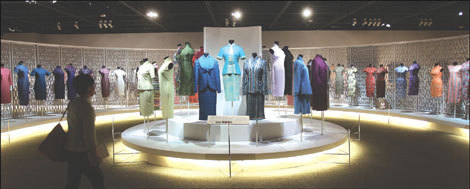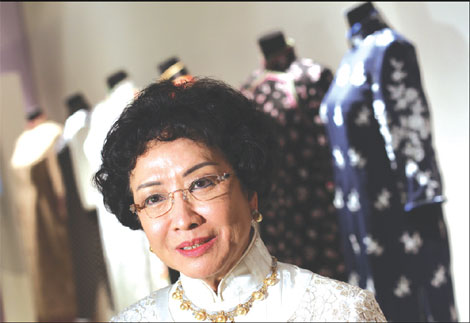The dress caught the attention of the West, when actress Nancy Kwan, who was cast in the role of a Wan Chai bar girl, wore a qipao in the 1960s film, The World of Suzie Wong. Mok didn't care for the representation of the dress in the film. He found the costumes crass, overshadowing the natural inner beauty of women with excessive exposure of bare flesh.
|

The qipao exhibition features more than 270 traditional garments, many of which have been worn by legendary actresses and other celebrities.
|
"They (qipao) are feminine and sexy without being too explosive. There is a class or a quality about the qipao that complements Chinese women. They are just a beautiful combination. It shows off the slender figure too. They make every Chinese woman look beautiful," said professor Lorraine Justice, Director of the School of Design of the Hong Kong Polytechnic University. She is fascinated by the transformation of the garments throughout their history.
"It has come down through history with influences of the Manchurian. Changes to the costume over the years have been just fabulous because they really show the exquisiteness of Chinese women who wear it. It was just beautiful."
Gwen Kao, wife of Nobel laureate Charles Kao, worn a bluish purple qipao at the Nobel Prize Award ceremony in 2009. Qipao is also a popular choice for celebrities to be worn at international occasions to show a sign of Chinese. Actress Michelle Yeoh Choo Kheng wore a qipao covered with shining tawny beads when she attended the Festival de Cannes.
Vera Waters, 74, is a collector of the qipao with about 350 pieces in her wardrobe. Each has its own accessories of the same color and tone. She says she's been wearing qipao since she was a student. As a Chinese, she says she is proud to wear the garment, to represent the culture of her people.
|

Vera Waters, a collector of the qipao, says she has been wearing qipao since she was a student.
|
"I wear qipao because I am a Chinese," said Waters whose husband is British. "My husband will see me wearing a different style of qipao everyday."
Waters says she learned to appreciate the beauty of the style when she traveled abroad.
"Western fashion design is eye-catching because of the exposure of flesh and the remarkable features added but qipao depends very much on the figure of the person."
Waters is still wearing the qipao today. She calls the fashion timeless. Not just that, she says a dress made 20 years ago still can be worn today, as long as the body shape remains basically unchanged.
"Because of the fitting, you'll notice once when the dress makes you feel tight. This is when you have to control your diet. It thus helps you keep fit," Waters said with a laugh.
She is perturbed by the fact that it is more difficult to find a good tailor these days. Her tailor of many years, now in his 70s is about to retire.
"Generally it takes about three days for an experienced tailor to make a quality qipao which costs about HK$2,500. Fewer tailors are willing to spend that much time for such a low return."
To renovate the traditional garment in today's society, professor Justice thinks designers have to play with it.
"The fashion of today does allow people to have a lot more fun through the different things they can choose and they can show their personalities more through the clothes and things they choose. It is all about self-expression in a very loud way and about individuality and in a way that is attention getting," Justice said. "But the qipao is a way to quietly show beauty without calling for attention or inviting certain things."
She suggested a shorter qipao is more suited to modern culture.
"Maybe alter them a bit, or have fun with today's fabrics. Maybe they can be cut a bit differently because women's bodies today are a little bit different."
To Yeung, fashion is a way to represent individuality, but it's also a channel for keeping the younger generation in touch with the traditions of modesty, gentleness and elegance.
"We Hong Kong people, especially the younger generation, should recognize our national culture. We have to show our national spirit," he said.
(China Daily July 8, 2010)